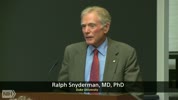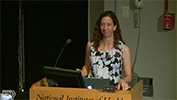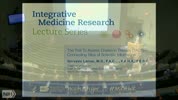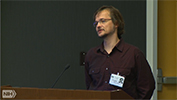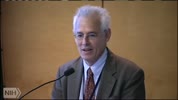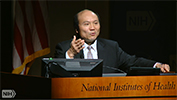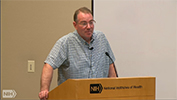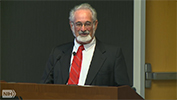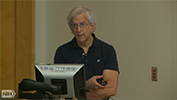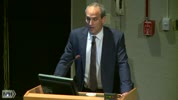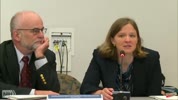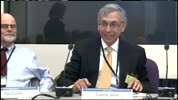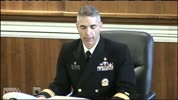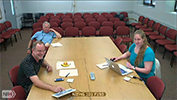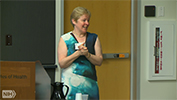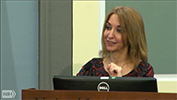-
- NIH VideoCast - AIDS Research Advisory Committee - May 2015
-
- - Division of AIDS, NIAID, NIH (2015/05/22)
- - Category : AIDS Research Advisory Committee
- May 18, 2015 AIDS Research Advisory Committee Meeting
NIH VideoCast - AIDS Research Advisory Committee - May 2015
-
- NIH VideoCast - Lasker Lessons in Leadership - From Brooklyn to Lab Bench to Board Room: Lessons Learned
-
- - Ralph Snyderman, MD, PhD, Duke University (2015/05/22)
- - Category : Special
- Lasker Lessons in Leadership is a lecture series aimed at bringing top scientists and medical leaders to the NIH to serve as inspiration for future leadership amongst the MD/PhD and PhD students enrolled in the NIH Oxford-Cambridge Scholars Program and the NIH Lasker Clinical Research Scholars Program.
Sponsored by the Albert and Mary Lasker Foundation, International Biomedical Research Alliance, NIH Oxford-Cambridge Scholars Program, Certara, and WCG
For more information go to http://oxcam.gpp.nih.gov
NIH VideoCast - Lasker Lessons in Leadership - From Brooklyn to Lab Bench to Board Room: Lessons Learned
-
- NIH VideoCast - Lost in Translation: Do males and females read their genomes differently?
-
- - David C. Page, M.D., Director, Whitehead Institute; Professor of Biology, Massachusetts Institute of Technology; Investigator, Howard Hughes Medical Institute (2015/05/22)
- - Category : WALS - Wednesday Afternoon Lectures
- The Wednesday Afternoon Lecture Series presents the annual Marshall W. Nirenberg lecture
"Nothing in biology makes sense except in the light of evolution." (Theodosius Dobzhansky, 1973). Dobzhansky???s oft-quoted dictum is highly relevant to our understanding of the manifold differences between males and females in health and disease, both within and beyond the reproductive tract. From the origins of sexual reproduction, in single-celled organisms, to the morphing of our own sex chromosomes from ordinary autosomes during the past 200-300 million years, comparative and evolutionary analyses offer deep, biologically grounded insights into the epigenetic, genomic, and phenotypic differences between the sexes. The emerging evolutionary view serves as an alternative, or complement, to the model (chromosomal sex > gonadal sex > phenotypic sex) that has guided teaching and research for the last half century. The opportunity now presents itself to capitalize upon this emerging evolutionary view of sex differences and their origins.
Most recently, Dr. Page and colleagues have conducted comparative genomic and evolutionary studies of the sex chromosomes of humans, other mammals, and birds. These studies have revealed that the Y chromosome`s gene content became specialized, through natural selection, to maintain the ancestral dosage of homologous X-Y gene pairs that function as broadly expressed regulators of the genome and gene activity; these X-Y gene pairs regulate transcription, translation, and protein stability (Bellott et al., Nature 508: 494-499, 2014). As a result, there exists a fundamental sexual dimorphism???at a biochemical level and throughout the body???that derives directly from genetic differences between the X and Y chromosomes. This fundamental sexual dimorphism may play an unappreciated role in health and disease in both males and females.
About the Annual Marshall W. Nirenberg Lecture:
The lecture, established in 2011, honors Marshall W. Nirenberg for deciphering the genetic code, which resulted in his sharing the 1968 Nobel Prize in Physiology or Medicine. Dr. Nirenberg`s career at NIH spanned more than 50 years and his later research focused on neuroscience, with particular emphasis on neural development. The Nirenberg lecture recognizes scientists who have made outstanding contributions to genetics and molecular biology.
For more information go to https://oir.nih.gov/wals
NIH VideoCast - Lost in Translation: Do males and females read their genomes differently?
-
- NIH VideoCast - Thymocyte: stromal cell crosstalk governing normal and neoplastic T cell development
-
- - Lauren Ehrlich, Ph.D., Tenure-Track Faculty, Molecular Genetics & Microbiology, University of Texas at Austin (2015/05/22)
- - Category : Immunology
- Immunology Interest Group
During her graduate work in Mark Davis`s lab at Stanford University, Lauren Ehrlich`s studies focused on elucidating the spatial and temporal recruitment of TCR-proximal signaling molecules to Immunological synapses of developing T cells undergoing negative selection and mature T cells undergoing activation. Her seminal publications on this work (Immunity, 16:595-606;2002 and Immunity, 17:809-822; 2001) were the first reports of immune synapse formation during thymocyte maturation and showed that the synapses formed in the thymus differ qualitatively from those generated after mature T cell activation. During her postdoctoral time in Irv Weissman`s lab at Stanford, Lauren developed a live 2-photon imaging approach to visualize the migration of purified thymocyte subsets throughout all regions of the thymus. This approach enabled her studies demonstrating that only the most mature thymocytes have the capacity to migrate within the medulla, and GPCR signals beyond CCR7 were required for thymocyte medullary entry (Immunity, 31:986-998; 2009). She also carried out a series of studies demonstrating that common lymphoid progenitors are lymphoid committed in vivo and are the most immediate BM precursors that initate thymopoiesis. Since starting her own lab at The University of Texas at Austin, Lauren has continued to pursue her interest in the contribution of thymocyte:stromal interactions to differentiation of a diverse, non-autoreactive T cell pool. She has also begun to investigate the importance of thymocyte/stromal interactions in mouse models of T cell acute lymphoblastic leukemia (T-ALL). These studies have yielded the striking findings that the thymic microenvironment is dramatically altered in T-ALL, and that the changes in thymus stromal composition are critical for tumor maintenance and growth. Lauren`s results, which have clear translational relevance in addition to providing new insights into T cell developmental biology are of broad interest to the immunology community.
For more information go to http://sigs.nih.gov/immunology/Pages/default.aspx
NIH VideoCast - Thymocyte: stromal cell crosstalk governing normal and neoplastic T cell development
-
- NIH VideoCast - The Trial To Assess Chelation Therapy (TACT) - Connecting Silos of Scientific Information
-
- - Gervasio Lamas, M.D., F.A.C.C., F.A.H.A., F.E.S.C., chairman of medicine at Mount Sinai Medical Center and chief of the Columbia University Division of Cardiology at Mount Sinai Medical Center (2015/05/20)
- - Category : National Center for Complementary and Integrative Health
- NCCIH Integrative Medicine Research Lecture
The National Center for Complementary and Integrative Health (NCCIH; formerly NCCAM) presents the Integrative Medicine Research Lecture Series. The series provides overviews of the current state of research and practice involving complementary health approaches and explores perspectives on the emerging discipline of integrative medicine.
Gervasio Lamas, M.D., F.A.C.C., F.A.H.A., F.E.S.C., is the chairman of medicine at Mount Sinai Medical Center and chief of the Columbia University Division of Cardiology at Mount Sinai Medical Center. Dr. Lamas is also professor of medicine at Columbia University College of Physicians and Surgeons and co-director of the Mount Sinai Heart Institute. In this lecture, Dr. Lamas will discuss his research exploring the effects of chelation therapy on coronary heart disease. Dr. Lamas will also talk about the benefits and risks of chelation therapy, interpret its effects on patients with diabetes, and provide insights for future chelation therapy research.
For more information go to https://nccih.nih.gov/news/events/IMlectures
NIH VideoCast - The Trial To Assess Chelation Therapy (TACT) - Connecting Silos of Scientific Information
-
- NIH VideoCast - Neural mechanisms of real-time decisions
-
- - Paul Cisek, Ph.D., University of Montreal (2015/05/20)
- - Category : Neuroscience
- Neuroscience Seminar Series
Dr. Cisek is interested in how the brain controls behavior. Many scientists approach this very large question by starting with perception and asking how the brain builds an internal representation of the world, and how it then uses this representation to guide action. In contrast, he studies behavior by starting with a concrete task such as a voluntary movement and asking what parameters of the task the brain must specify and control, and what information from the environment it may employ toward that specification. The goal here is an understanding of brain mechanisms for mediating interaction with the world, not necessarily of mechanisms for representing the world. A research program based on such an approach begins with questions concerning motor control and gradually works its way toward the perceptual systems which guide that control. One could say he is going backwards through the brain.
NIH VideoCast - Neural mechanisms of real-time decisions
-
- NIH VideoCast - Division of Allergy, Immunology and Transplantation Subcommittee - May 2015
-
- - NIAID, NIH (2015/05/20)
- - Category : National Institute of Allergy and Infectious Diseases
- Report from Division Director and Division Staff
NIH VideoCast - Division of Allergy, Immunology and Transplantation Subcommittee - May 2015
-
- NIH VideoCast - Kuan-Teh Jeang Memorial Lecture: Dissecting the Molecular Anatomy of HCV Infection at the Crossroads of Functional Genomics and Chemical Biology
-
- - T. Jake Liang, M.D., Chief, Liver Disease Branch, Deputy Director of Translational Research, NIDDK, NIH (2015/05/19)
- - Category : Special
- Kuan-Teh Jeang Memorial Lecture
This year`s speaker is Dr. T. Jake Liang, Chief, Liver Disease Branch Deputy Director of Translational Research, NIDDK, NIH
The program is co-sponsered by the National Institute of Allergy and Infectious Diseases, the NIH Office of Equity, Diversity and Inclusion; and the NIH Office of Intrumural Research
For more information, visit
http://www.niddk.nih.gov/about-niddk/staff-directory/intramural/liangtj/pages/research-summary.aspx
NIH VideoCast - Kuan-Teh Jeang Memorial Lecture: Dissecting the Molecular Anatomy of HCV Infection at the Crossroads of Functional Genomics and Chemical Biology
-
- NIH VideoCast - National Library of Medicine - Board of Regents, Advisory Council - May 2015 (Day 2)
-
- - NLM, NIH (2015/05/16)
- - Category : Advisory Board Meetings
- NLM Advisory Council Meeting
Board of Regents Agenda
For more information go to http://www.nlm.nih.gov/od/bor/bor.html
NIH VideoCast - National Library of Medicine - Board of Regents, Advisory Council - May 2015 (Day 2)
-
- NIH VideoCast - Beyond the Sentinel: A Modern Approach for Detecting Rodent Pathogens
-
- - Dr. Ken Henderson, Charles River Laboratories (2015/05/16)
- - Category : Special
- The combination of PCR technology and environmental monitoring offers the possibility of replacing or reducing the use of sentinel rodents in the Animal Health Surveillance programs for laboratory animal colonies. Dr.Ken Henderson of Charles River Laboratories will discuss recent advances in this area.
NIH VideoCast - Beyond the Sentinel: A Modern Approach for Detecting Rodent Pathogens
-
- NIH VideoCast - E-cigarettes: Back to the Future
-
- - Stanton A Glantz, Ph.D., Professor of Medicine, University of California, San Francisco (UCSF) School of Medicine (2015/05/16)
- - Category : Special
- NIDCR Clinical Research Fellowship Grand Rounds
Promoted as a safer alternative to conventional cigarettes, the use of e-cigarettes has grown rapidly. This growth in e-cigarette users -- particularly among teens and young adults -- raises the question of how to respond to the introduction of a new product when the possible health and behavioral effects have not been defined. Dr. Glantz???s presentation will review what is known about the health and behavioral effects of e-cigarettes and identify important determinants of the long-term population health impacts of e-cigarettes.
Dr. Glantz is a widely recognized researcher with a reputation for identifying and pursuing high-impact questions that make practical contributions to tobacco control policy development, evaluation, and implementation. As Director of the UCSF Center for Tobacco Control Research and Education (CTCRE) and the Principal Investigator of the UCSF Tobacco Center of Regulatory Science (TCORS), he has extensive practical experience in developing and managing transdisciplinary academic programs.
Skilled in both qualitative and quantitative research methods, Dr. Glantz has authored several books on tobacco control policy as well as two successful statistics textbooks. His journal articles reflect extensive knowledge in a broad range of tobacco control areas, including economic models of the effects of tobacco control policies on health outcomes and health care costs, social and environmental determinants of smoking and smoking cessation, young adult smoking, and health effects of secondhand smoke, particularly on heart disease. In 1995 in JAMA, Dr. Glantz was the first to publish analyses of previously secret tobacco industry documents.
NIH VideoCast - E-cigarettes: Back to the Future
-
- NIH VideoCast - Overcoming platinum resistance in tumor cells by novel thioxodihydroquinazolinone (TDQ) small molecules
-
- - Dr. Wei Qian, University of Pittsburgh Cancer Institute (2015/05/15)
- - Category : DNA Repair
- DNA Repair Intererst Group videoconference
Acrobat Slides
NIH VideoCast - Overcoming platinum resistance in tumor cells by novel thioxodihydroquinazolinone (TDQ) small molecules
-
- NIH VideoCast - NIA - National Advisory Council on Aging (NACA) May 2015
-
- - NIA, NIH (2015/05/15)
- - Category : Clinical Center Grand Rounds
- The National Advisory Council on Aging (NACA) advises the Secretary of the U.S. Department of Health and Human Services, the Director of NIH, and the Director of NIA on its mission. The Council meets three times a year to consider applications for research and training.
NIH VideoCast - NIA - National Advisory Council on Aging (NACA) May 2015
-
- NIH VideoCast - CC Grand Rounds: Contemporary Clinical Medicine: Great Teachers: Video Game Medicine at the NIH: How Image-Guided Therapies Depend Upon Interdisciplinary Translational Team Science
-
- - Bradford Wood, MD Director, NIH Center for Interventional Oncology, CC and NCI and Chief, Interventional Radiology Section, Radiology and Imaging Sciences, CC, NIH (2015/05/15)
- - Category : Clinical Center Grand Rounds
- CC Grand Rounds: Contemporary Clinical Medicine: Great Teachers: Video Game Medicine at the NIH: How Image-Guided Therapies Depend Upon Interdisciplinary Translational Team Science
For more information go to http://www.cc.nih.gov/about/news.grcurrent.html
NIH VideoCast - CC Grand Rounds: Contemporary Clinical Medicine: Great Teachers: Video Game Medicine at the NIH: How Image-Guided Therapies Depend Upon Interdisciplinary Translational Team Science
-
- NIH VideoCast - Expert Panel: Identifying Research Needs for Assessing Safe Use of High Intakes of Folic Acid (Day 1)
-
- - National Toxicology Program and Office of Dietary Supplements (2015/05/14)
- - Category : Conferences
- The National Toxicology Program (NTP) and Office of Dietary Supplements (ODS) are convening an expert panel to identify research needs related to the safe use of high intakes of folic acid based on consideration of the state of the science. The expert panel meeting will bring together experts from multiple disciplines including, but not limited to, epidemiology, nutrition, medicine, and toxicology. In preparation for this evaluation, screening of the literature was undertaken to identify potential adverse health effects for which further research might be warranted. A literature review document is being prepared on four health outcome areas using systematic review methodology: (1) cancer, (2) cognition in conjunction with vitamin B12, (3) hypersensitivity-related outcomes, and (4) endocrine and metabolic outcomes. The literature review document should be available by April 6, 2015, and will be posted to http://ntp.niehs.nih.gov/go/730864. A document describing the approach for conducting the literature evaluation has also been prepared and is posted on the NTP Website (http://ntp.niehs.nih.gov/ntp/ohat/folicacid/ntpfolicacid_approach_508.pdf). This document describing the approach includes information on the dose levels of folic acid being considered for the evaluation.
For more information go to http://ntp.niehs.nih.gov/go/730864
NIH VideoCast - Expert Panel: Identifying Research Needs for Assessing Safe Use of High Intakes of Folic Acid (Day 1)
-
- NIH VideoCast - Expert Panel: Identifying Research Needs for Assessing Safe Use of High Intakes of Folic Acid (Day 2)
-
- - National Toxicology Program and Office of Dietary Supplements (2015/05/14)
- - Category : Conferences
- The National Toxicology Program (NTP) and Office of Dietary Supplements (ODS) are convening an expert panel to identify research needs related to the safe use of high intakes of folic acid based on consideration of the state of the science. The expert panel meeting will bring together experts from multiple disciplines including, but not limited to, epidemiology, nutrition, medicine, and toxicology. In preparation for this evaluation, screening of the literature was undertaken to identify potential adverse health effects for which further research might be warranted. A literature review document is being prepared on four health outcome areas using systematic review methodology: (1) cancer, (2) cognition in conjunction with vitamin B12, (3) hypersensitivity-related outcomes, and (4) endocrine and metabolic outcomes. The literature review document should be available by April 6, 2015, and will be posted to http://ntp.niehs.nih.gov/go/730864. A document describing the approach for conducting the literature evaluation has also been prepared and is posted on the NTP Website (http://ntp.niehs.nih.gov/ntp/ohat/folicacid/ntpfolicacid_approach_508.pdf). This document describing the approach includes information on the dose levels of folic acid being considered for the evaluation.
For more information go to http://ntp.niehs.nih.gov/go/730864
NIH VideoCast - Expert Panel: Identifying Research Needs for Assessing Safe Use of High Intakes of Folic Acid (Day 2)
-
- NIH VideoCast - National Library of Medicine - Board of Regents, Advisory Council - May 2015 (Day 1)
-
- - NLM, NIH (2015/05/14)
- - Category : Advisory Board Meetings
- NLM Advisory Council Meeting
Board of Regents Agenda
For more information go to http://www.nlm.nih.gov/od/bor/bor.html
NIH VideoCast - National Library of Medicine - Board of Regents, Advisory Council - May 2015 (Day 1)
-
- NIH VideoCast - Tetrameric Ctp1 coordinates DNA binding and bridging in DNA double-strand break repair
-
- - Dr. Sara Andres, NIEHS, NIH (2015/05/14)
- - Category : DNA Repair
- DNA Repair Intererst Group videoconference
Acrobat Slides
NIH VideoCast - Tetrameric Ctp1 coordinates DNA binding and bridging in DNA double-strand break repair
-
- NIH VideoCast - Genetic risk for Alzheimer`s disease: an emerging role for rare variants
-
- - Alison Goate, Ph.D., Professor of Neuroscience, and Director of the Center on Alzheimer`s Disease, Mount Sinai School of Medicine (2015/05/13)
- - Category : Neuroscience
- Neuroscience Seminar Series
Research in Dr. Goate???s laboratory focuses on dementia (Alzheimer`s disease & frontotemporal dementia) and addiction (alcohol dependence). In each of these projects their goal is to understand the molecular basis of disease in order to identify novel targets for therapeutic development. They use genetic and genomic approaches to identify susceptibility alleles, this work includes genome wide association studies and whole genome/exome sequencing in families multiply affected by disease and in case control cohorts. They have also pioneered the use of endophenotypes to uncover both risk and protective alleles in both their Alzheimer`s disease and their alcoholism studies. They have developed induced pluripotent stem cells from individuals with known genetic causes of disease in order to model the effects of these mutations in disease relevant cell types. Functional studies are being undertaken to understand the role of phospholipase D3 variants in Alzheimer`s Disease risk, tau mutations in frontotemporal dementia and alpha 5 nicotinic receptor variants in addiction.
NIH VideoCast - Genetic risk for Alzheimer`s disease: an emerging role for rare variants
-
- NIH VideoCast - Neutrophils in the pathogenesis of systemic autoimmune diseases: casting the NET widely
-
- - Mariana J. Kaplan, M.D. Senior Investigator and Chief, Systemic Autoimmunity Branch, NIAMS, NIH (2015/05/12)
- - Category : NIH Director`s Seminars
- NIH Director`s Seminar Series
Systemic autoimmune diseases comprise a clinically heterogeneous group of disorders characterized by a failure in self-tolerance to a wide variety of intracellular autoantigens, and include conditions like systemic lupus erythematosus, rheumatoid arthritis and anti-neutrophil cytoplasmic antibody associated-vasculitis.
Work at the Systemic Autoimmunity Branch has focused on characterizing the role that aberrant neutrophils play in the promotion of loss of immunological tolerance, amplification of inflammatory responses and direct end-organ damage in these diseases. One characteristic of neutrophils is their capacity to form neutrophil extracellular traps (NETs) upon exposure to danger signals. Dr. Kaplan`s group identified a distinct subset of proinflammatory neutrophils in patients with specific systemic autoimmune diseases (lupus, vasculitis) that display exuberant capacity to form NETs in the absence of infection. She has proposed that NETs may play important roles in the pathogenesis of systemic autoimmune diseases through externalization and modification of intracellular antigens, induction of distinct proinflammatory pathways and deleterious effects on the vasculature and other tissues. Her group has proposed a pathogenic crosstalk between neutrophils and type I IFNs that leads to crucial pro inflammatory pathways in lupus and its associated vascular damage.
Dr. Kaplan and her group have identified putative pathways of NET inhibition in autoimmune diseases that abrogate clinical phenotype, immune dysregulation and vasculopathy in lupus and atherosclerosis animal models. Ongoing studies are focusing on identifying mechanisms and pathways leading to autoimmune NET formation, their pathogenic implications in human disease and in the identification of novel therapeutic targets.
NIH VideoCast - Neutrophils in the pathogenesis of systemic autoimmune diseases: casting the NET widely




